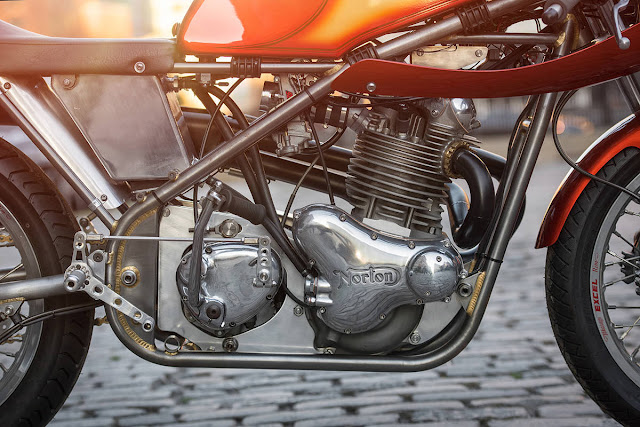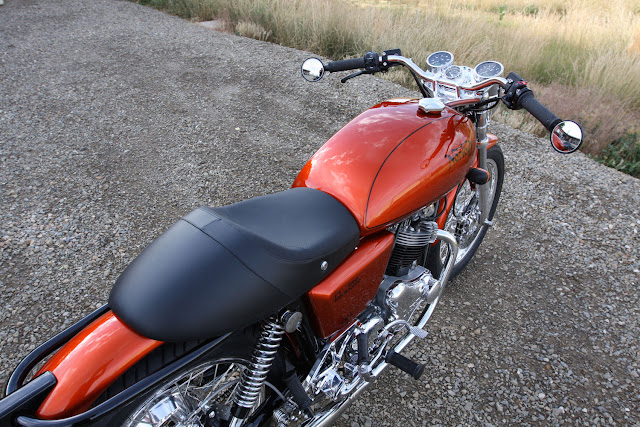Norton Commando
The stylish Commando S, with its high- level exhaust pipes on the left, was introduced in 1969 mainly to gain sales in America, where off-road riding was popular.
The classic Commando look combines the angled-forward parallel twin engine with Norton’s so-called Fastback tailpiece, designed more for style than pillion comfort.
For many riders, the Norton Commando was the ultimate bike of the late 1960s and early ’70s. It combined a powerful, torquey engine with a fine-handling chassis that minimized the traditional British parallel twin problem of vibration.
The original Commando, launched in 1968, was powered by a 745cc pushrod-operated parallel twin motor that was based on that of the previous Atlas, but was angled forward in the chassis instead of positioned vertically. Changes included higher compression ratio and a single-plate diaphragm clutch. Peak power was 58bhp at 6800rpm.
But it was the chassis that made the Commando special; more specifically, the ‘Isolastic’ system of rubber mounting that promised to get rid of the vibration that had plagued the Atlas and other larger-capacity British parallel twins. The system, developed by a team headed by former Rolls-Royce engineer Dr Stefan Bauer, attached the engine to the frame by rubber mounts. The frame itself comprised a large main spine plus twin downtubes.
Rear engine plates were also rubber-mounted, isolating the motor while allowing the frame’s spine to counter torsional stresses.
The Commando, which combined this chassis innovation with striking styling including a streamlined ‘Fastback’ tailpiece, made an immediate impact. The bike was fast, with a top speed of 115mph (185km/h) and strong mid-range acceleration. More to the point, the Isolastic frame really worked. Firstly, it succeeded in isolating the rider from vibration effectively, at least so long as the Isolastic bushes were well maintained. And in combination with Norton’s Roadholder forks and Girling shocks, it gave handling that was well up to the old firm’s traditional high standards.
Terrific power
Magazine tests were full of praise. Motor Cycle, reviewing the Commando’s impact several months after its launch, summed-up: ‘The terrific power of the modified 745cc Atlas twin was a new experience now it was rubber-mounted in an ingenious frame which did, in fact, virtually eliminate the effects of high-frequency vibration. The sceptics retired to swallow their doubts. Overnight the Commando became the most sought- after large-capacity roadster on the market.’
After a further 2000-mile (3200km) trip, the tester concluded that the Norton ‘gave a new dimension to the sort of riding we have known on parallel twins in the past 20 years’. The Commando proceeded to win the Motor Cycle News Machine of the Year competition five years in a row. American riders also took to the Commando which, for that very important market, was fitted with high, wide handlebars.
Americans benefited from some of the special versions that Norton developed over the next few years, notably the 1971 model Commando SS, a 'treet scrambler with a small gas tank and high- svel pipes. The Commando Hi-Rider model added .. chopper-style seat to its similar tank and high- evel bars. Norton went the opposite way with the Combat Commando, which had flatter bars to suit ts tuned, high-compression 65bhp motor. But theCombat was an embarrassment. Its main bearings could not handle the extra power, and Norton’s hurried attempts to fix the problem with a new head gasket backfired when these started leaking.
The factory had much more success in 1973, when the engine was bored-out to create the Commando 850, available in standard Roadster and large-tanked Interstate options. The bigger motor’s extra torque gave a welcome performance boost to a parallel twin that by now was competing against Japanese multis. But the British bike’s limitations were highlighted by Norton’s difficulty in providing a reliable electric starter. By now parent company Norton Villiers Triumph was in financial trouble, and production finally ceased in 1977.
The Commando gave Norton fresh life, hut even by enlarging the original 745cc engine to 828cc it could not keep the pushrod twin competitive in the 1970s.
This 1972 specification machine was assembled in 1995 from new parts by British Norton parts specialist Fair Spares, one of several firms to offer freshly built Commandos.
Specification Norton Commando (1968)
- Engine Air-cooled ohv four-valve pushrod parallel-twin
- Capacity 745cc (73 x 89mm)
- Maximum power 58bhp @ 6800rpm
- Transmission Four-speed, chain final drive
- Frame Steel spine with twin downtubes
- Suspension Telescopic front; twin shock rear
- Brakes Drum front and rear
- Weight 420lb (191kg)
- Top speed 115mph (185km/h)























0 comments: